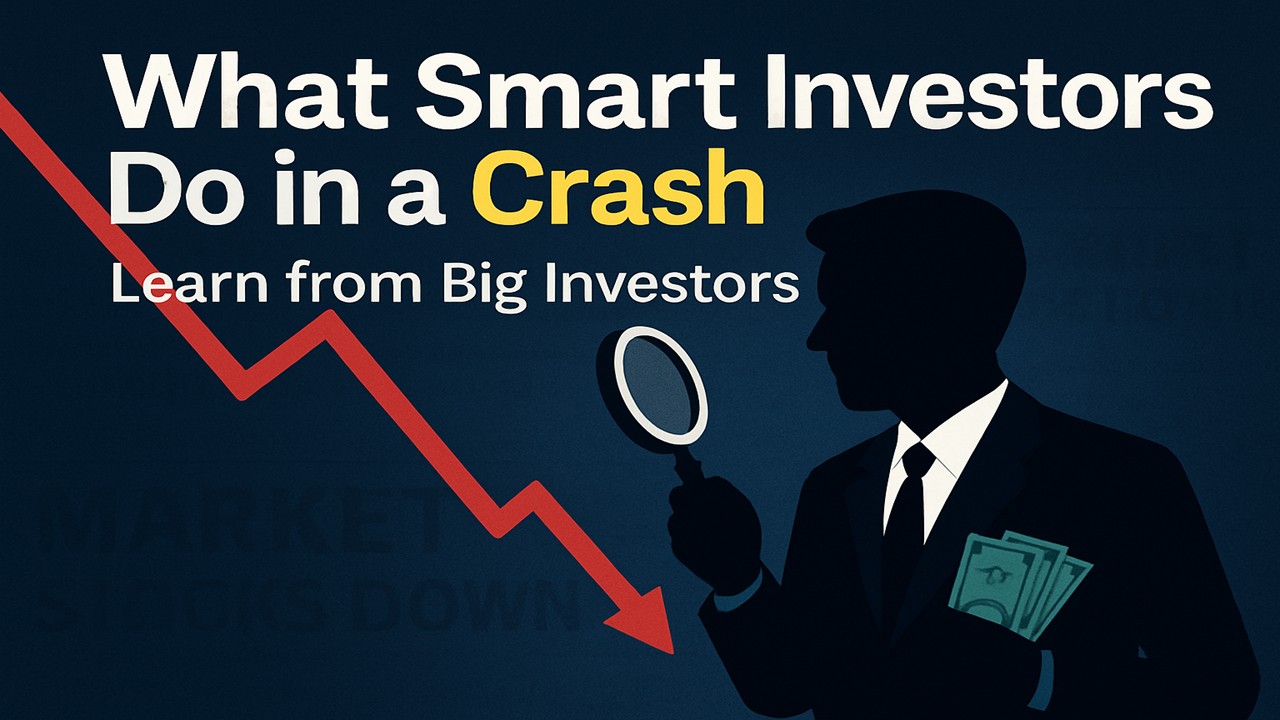
A Crash Hits! Now What?
Imagine this:
You wake up and see this headline –
“Nifty tanks 800 points!”
You check your investment app.
Your portfolio drops from ₹5 lakhs to ₹3.6 lakhs… overnight.
Your first thought?
“Should I sell everything before I lose more?”
But guess what?
This is the exact moment when big investors smile and get ready to buy.
What is a Stock Market Crash — Really?
A stock market crash is a sharp and sudden fall in index levels like Sensex or Nifty, usually triggered by:
- 🌍 Global crises (war, pandemic, etc.)
- 📉 Recession or economic slowdown
- 📊 Inflation or rising interest rates
- 💬 Negative investor sentiment
But what does history say?
Markets may fall, but they eventually bounce back stronger.
📚 Crash & Recovery: Real Examples from History
| Year | Event | Crash | Recovery Time | Returns If You Stayed |
| 2008 | Lehman Crisis | –60% | 2 years | 120%+ |
| 2020 | COVID-19 Pandemic | –38% | 6 months | 100%+ |
| 2022 | Ukraine War | –15% | 3 months | 25–30% |
Analysis:
- Those who panicked and sold: Booked heavy losses
- Those who held on or invested more: Earned huge returns
Buffett’s Rule: Use Fear to Your Advantage
“Be fearful when others are greedy, and greedy when others are fearful.” — Warren Buffett
This simply means:
Buy when there’s panic. That’s when long-term wealth is made.
How Smart Investors Handle Crashes — Step-by-Step with Real Examples
1. Keep Cash Ready – Buy When Others Panic
Big investors always keep a cash reserve ready.
They wait for crashes to grab quality stocks at discounted prices.
Example:
Rakesh Jhunjhunwala bought Titan at ₹30–40, and added more during market falls.
Today, Titan trades above ₹3,500+.
Strategy:
- Always save some cash for such opportunities
- Don’t rush — buy in small amounts during dips
2. Continue SIPs — Let Volatility Work for You
In a crash, NAV drops, and your SIP buys more units.
This helps average out your cost and gives better returns long-term.
Example:
Investors who continued SIPs during the 2020 crash saw 50%+ returns within a year.
Strategy:
- Never stop your SIPs in panic
- Crashes are when SIPs perform their best
3. Stick to Quality Stocks — Don’t Dump the Best
In fear, many investors sell even the best stocks.
Smart investors hold or buy more of fundamentally strong companies like:
- HDFC Bank
- Infosys
- TCS
- Reliance
- Asian Paints
Example:
Infosys dropped to ₹110 in 2008, but rose to ₹900+ by 2014.
Those who stayed invested gained massively.
Strategy:
- Focus on companies with strong financials
- Avoid weak or over-hyped stocks
4. Rebalance Your Portfolio — Clean It Up
Crashes reveal the true strength of your investments.
Smart investors use this time to:
❌ Exit underperforming stocks
✅ Shift to better, stronger options
Example:
A small-cap stock falls 80%, but Infosys falls only 20% —
Switching may be the smarter move.
Strategy:
- Use data, not emotions
- Reinvest in fundamentally better companies
5. Control Emotions — Don’t React to Headlines
Most retail investors follow panic-driven news or WhatsApp “experts.”
Smart investors follow data and logic — not noise.
Reality:
Retail investors often sell at the bottom, while big investors buy at that very moment.
🎯 Strategy:
- Don’t react emotionally
- Ignore short-term noise
- Stick to your long-term vision
What You Should Do During a Market Crash
✅ Continue your SIPs
✅ Maintain emergency funds
✅ Buy quality stocks on dips
✅ Rebalance your portfolio
✅ Think long term
✅ Learn, don’t fear
✅ Stay disciplined and calm
🚫 What You Should Avoid During a Crash
❌ Panic selling
❌ Taking loans to invest
❌ Blindly buying cheap stocks
❌ Trusting unverified tips
❌ Constantly checking portfolio
❌ Ignoring research before investing
Outcome: Crash is Not a Crisis — It’s a Golden Opportunity
“A crash isn’t the end — it’s a SALE for long-term wealth!”
Smart investors know:
Wealth isn’t created in the boom, it’s created in the fall —
when others are scared to invest.
So, next time when you hear:
“Oh no! The market is falling!”
Say instead:
“Yes! Time to buy smart and build wealth.”




































































